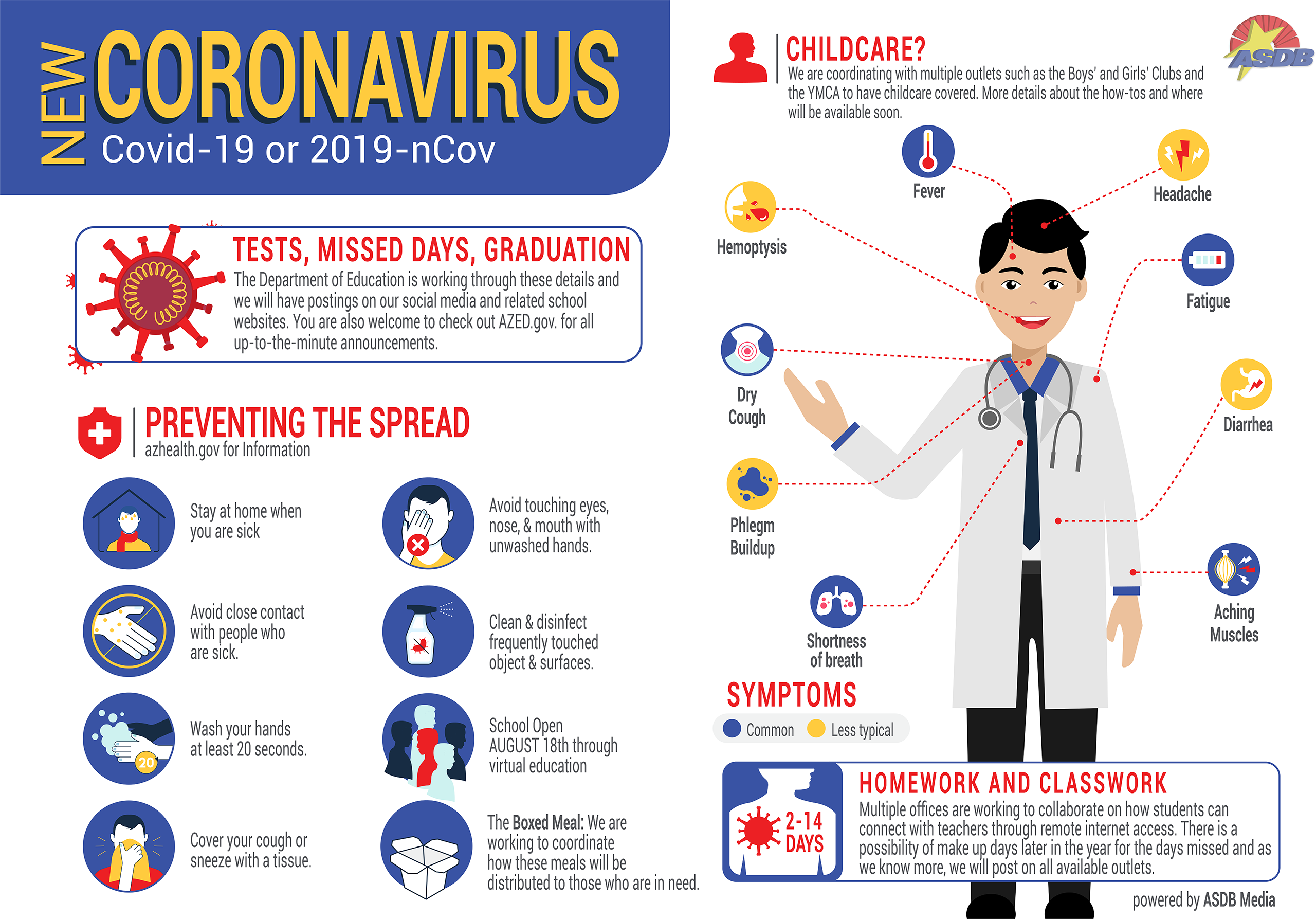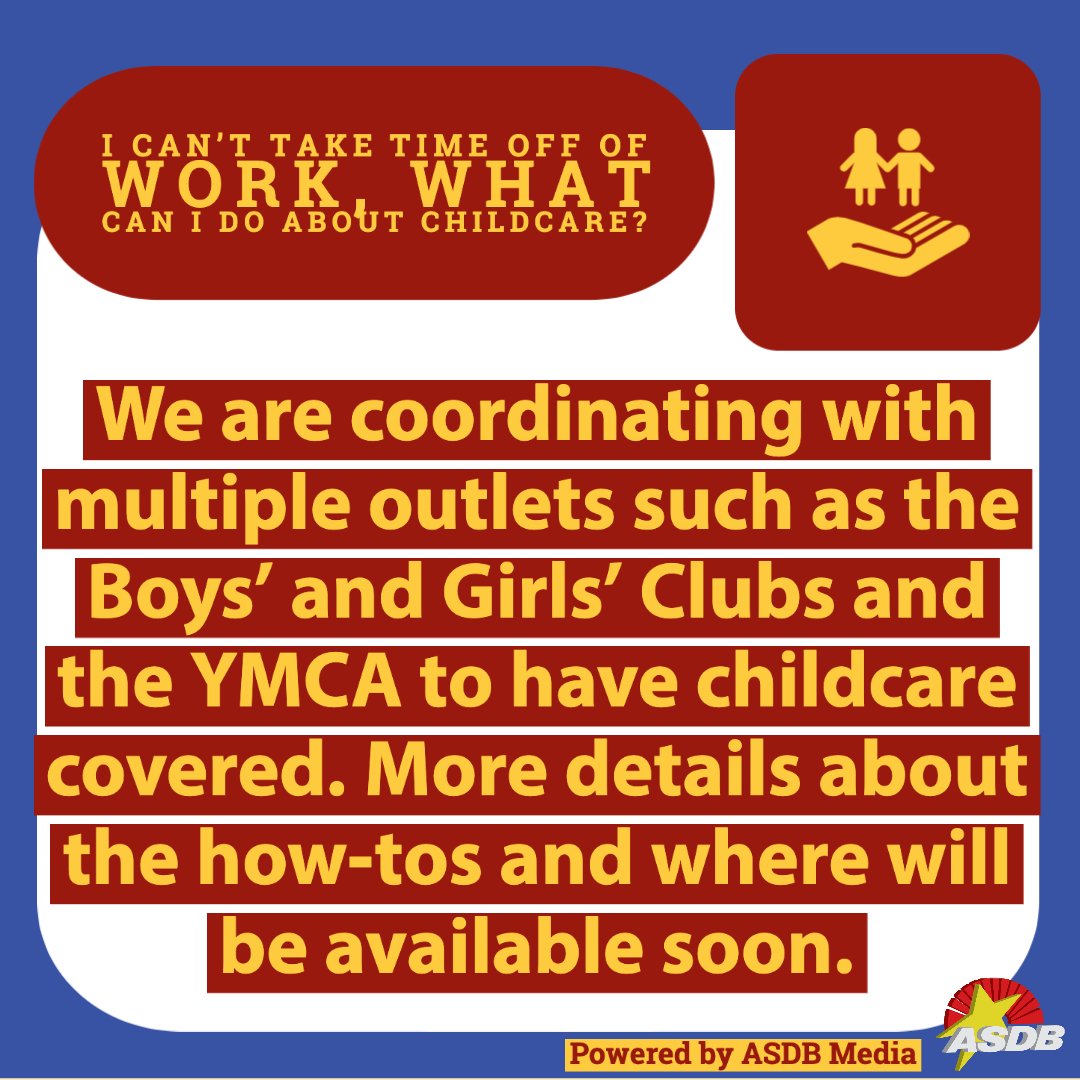COVID-19
Find all the latest updates for ASDB's response to COVID-19 Reopening Manual 2020-2021COVID-19 Mitigation PlanVideo updates
Helpful Links
Frequently Asked Questions
Q: There are concerns about accessibility for staff and students who are D/HH; are we allowed to wear clear face masks? Do we have to supply our own clear face masks?
A: 7/22/2020 ASDB has received 5,000 clear face masks from the Arizona Commission for the Deaf and the Hard of Hearing (ACDHH). The agency has ordered another 10,000 thousand masks to support staff that meet the agency wide risk assessment. The mask will not create a full seal around the mouth. The masks we have are PPE certified and approved for use. If you receive masks from the agency you are not to modify the mask, it will compromise the integrity of the mask use. The masks are a one time use mask. The agency will have to prioritize these masks to those staff that have been placed in the high risk category as determined by our risk assessment that was completed by supervisors. Additional masks will be ordered to support both safety and communication needs for those in positions of high risk. Please know that the agency has made every effort and due diligence and sometimes it might not be the ideal product, but reasonable within our means. Please refer to Risk Assessment and Clear Mask all staff email from Albert Duff dated July 22, 2020.
Q: How do I know if I am High Risk, Medium Risk or Low Risk?
A: 7/22/2020 The agency used a risk assessment to update our Blood Borne Pathogen (BBP) and Other Potentially Infectious Diseases (OPID) program. The program assists in creating a safe learning environment for staff and students. The agency will publish the results of the assessment for your review. Like this FAQ list it is a working document that may change over time and due to new developments. The role of this assessment is to assist the agency in ordering the correct Personal Protective Equipment (PPE) for those staff members in the high risk category.
Those staff members who are in the medium and low risk categories are asked to implement other safety measures: social distancing, wearing cloth face masks, increased hand washing, and contacting assistance for any bodily fluid cleanups.
Q: When should a person wear Personal Protective Equipment (PPE)?
A: 7/8/2020 PPE should always be worn when performing an activity that has a known risk.
Example: Wearing disposable gloves while cleaning up bodily fluids (saliva, blood, urine, throw up).
Q. When to wear cloth face covering vs. PPE, what is the difference?
A: A cloth face covering is a reusable covering to be worn over the mouth and the nose that protects the public from your saliva. PPE is Personal Protective Equipment that is designed and tested to protect the employee from a known hazard.
Example: Wearing protective eyeglasses that are rated to withstand an impact when working with equipment that can send a piece of debris up into the eye when using an electric saw.
Q. Are we required to wear face coverings?
A. 7/21/20 Yes, face coverings are required. Using the CDC as our guide to support working safely please refer to the email sent to all staff from Anita Pyeatt in HR dated July 21, 2020. This email is the latest update on face coverings. It will outline non-medical face coverings and face shields.
7/02/2020 Please refer to email ASDB COVID 19 Guidelines-Non-Medical Cloth Face Coverings from Anita Pyeatt in HR.
Q: What protocols should an employee follow if they have reason to believe a staff member has been exposed to COVID-19?
A: 7/5/2020 Staff and their supervisors will work with HR to support any staff member who may have been exposed to COVID 19. If you think you may have been exposed, if you are not feeling well with potential symptoms of COVID-19, contact your supervisor immediately. They will work with all employees to disseminate communication information and any next steps.
Q: What are the symptoms of COVID-19?
A: 7/4/2020 Symptoms may appear 2-14 days after exposure to the virus. People with these symptoms may have COVID-19:
-
Fever or chills
-
Cough
-
Shortness of breath or difficulty breathing
-
Fatigue
-
Muscle or body aches
-
Headache
-
New loss of taste or smell
-
Sore throat
-
Congestion or runny nose
-
Nausea or vomiting
-
Diarrhea
-
This list does not include all possible symptoms
Q: Should K-12 schools conduct universal coronavirus testing for students and staff when reopening this fall and should school staff be expected to directly administer tests.
A: 7/2/2020 No to both questions, says the Center for Disease Control (CDC).
Q: What happens if there is a positive COVID case at school?
A: In the event of a positive case, with a staff or student, we are recommending that we close the entire school for two weeks. Plans are developed depending on the situation. If there is a positive case (or report of flu-like symptoms) reported at the home of a student, that individual student would stay at home and be provided work to be completed at home. Staff will work with directors/principals to gain more information.
If there is a positive case for staff they would stay at home according to ADOA guidelines and may work remotely if eligible and if they can perform all duties. If their position is not conducive to work remotely, the staff member would report sick time through the CARES Act.
Q: When should I be tested for COVID-19?
A: 6/15/2020 ADOA guidance for state employees awaiting COVID-19 testing results (for non-emergency responders and non-health care providers):
A state employee should be tested for COVID 19 if they have symptoms of the virus or are concerned about close contact with an individual who has either tested positive for the virus, or has been told by their healthcare provider that they are presumed to be COVID-19 positive. Close contact is defined as being within 6 feet for longer than 10 minutes with someone who has COVID-19.
Once tested, the employee should stay at home and not return until they receive the test results. Eligible employees may telework pending their results if they are able to do so.
-
Employees with symptoms who have tested positive for COVID-19 should stay home until: they are fever free for at least 3 days (72) hours without the use of fever-reducing medications, AND Other symptoms have improved, AND at least 10 days passed since symptoms first appeared.
-
Employees with symptoms who have not been tested for COVID-19 or who are awaiting test results should stay home until: They are fever free for at least 3 days (72) hours without the use of fever-reducing medications, AND Other symptoms have improved, AND at least 10 days have passed since symptoms first appeared.
-
Employees with symptoms who have tested negative for COVID-19 should stay at home until: They are fever free for at least 3 days (72 hours) without the use of fever-reducing medication, AND Other symptoms have improved.
-
Employees without symptoms who test positive for COVID-19 by PCR testing should stay at home until 10 days have passed since their specimen was collected.
Q: What happens to support staff if school closes?
A: Not all hours of work can be guaranteed. Staff may be utilized to do the following:
-
Food Service-prepare meals and work with transportation to deliver meals.
-
Maintenance-Deep cleaning and disinfecting in all areas to prepare for school to reopen.
-
Transportation staff-assist in delivering meals on routes
-
Office staff-remote work
Q: What type of support is available to me during the Pandemic?
A: 7/13/2020 Please refer to the email sent by Anita Pyeatt from HR. One dated July 13, 2020 ASDB COVID-19 Guidelines-Families First Coronavirus Response Act (FFRCA) Updated 7/10/2020.
4/3/2020 Please refer to the email sent by Anita Pyeatt from HR. One dated April 3, 2020 Effective April 1, 2020-Families First Coronavirus Response Act (FFCRA) Employee Rights Notification.
Q: How do we know that proper cleaning and disinfection on campus is taking place for ASDB Tucson and PDSD?
A: Cleaning guidelines have been provided for what to do in common spaces, restrooms, classrooms, hallways, playgrounds, etc. Recommendations have been provided in the ADE roadmap for reopening schools and staff is being trained and plans have been developed for cleaning throughout each day at the schools.
Q: What happens if a staff member has traveled out of the country.
A: There is a 14 day quarantine period for staff that travel out of the country. If your job requires you to work in the office/campus you will need to work with HR. If your job is eligible for remote work, then you may work from home. If you have traveled out of the country, you need to contact your supervisor.
Q: I’m wearing my mask. What happens or why are some people not wearing masks?
A: All staff members are required to wear a mask unless they have been cleared through HR. Please keep in mind the agency supports staff privacy of each individual. Please respect each staff member’s privacy. However, some staff are required to wear PPE to address safety hazards as part of an essential function.
Q: With all this new information and changes is there a place for me as a PDSD or an ASDB school staff member of the schools to know about procedure changes, policies and practices? What if I am a cooperative, preschool or other agency employee?
A: **UPDATE 8/10/2020 Yes, A Staff Reopening Manual 2020-2021 has been developed. It has been shared with school staff by the principals. Also the preschools have protocols that they are developing and staff will receive guidance from their director and supervising teachers. For staff in the cooperatives the directors are working with individual school districts in developing the new protocols, practices and procedures. Each department is responsible for developing and sharing practices, protocols and procedures. Please reach out to your immediate supervisor for more information.
Q: When and who will provide school districts and charter schools health benchmarks for resuming in-person, teacher-led classroom instruction?
A: Arizona Department of Health Services is required to develop health benchmarks for resuming in-person, teacher-led classroom instruction. School districts and charters should consider the metrics when determining when to return to school. The metrics will be used in determining when we open for in person instruction at our schools.
Q: How will the 180 day requirement be affected with the release of the latest Executive Order 2020-44?
A: Both of our schools went to a 4 day instruction schedule. This means that they had to submit calendars to ADE and will be working with them to determine the numbers of hours that we will need to complete to claim our full voucher for our students.
Q: What qualifies as attendance tracking under a distance learning plan?
A: Schools and charters will have the flexibility to design attendance tracking procedures. Methods may include:
- Communication with a teacher via telephone, ZOOM, MIcrosoft Teams, or other digital meeting software;
- Student participation in a virtual meeting or classroom session (ZOOM Microsoft TEAMS, Google Meets, etc…);
- Daily assignments completed and submitted by a student; or A parental attestation or documentation of time spent on educational activities assigned by the school.
Please note, our schools are no longer considered an LEA and we are awaiting further instruction from ADE.
Q: Do absences need to be reported?
A: Attendance and absences must be recorded daily and reported to ADE at least monthly. The schools have a plan for attendance.
Q: Will schools get penalized for 10 or more consecutive unexcused absences?
A: Yes, ARS 15-901 requires students who generate 10 consecutive unexcused absences to be dropped, retroactive to the last day of unexcused absences. This topic is currently also under review with ADE.






